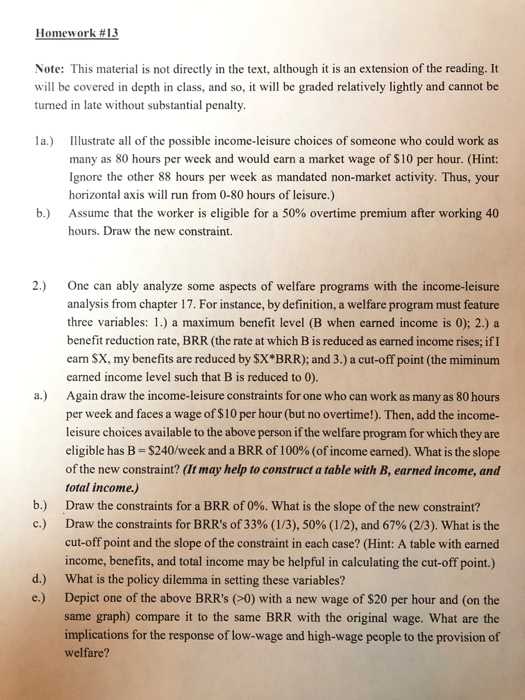Homework #13 Note: This material is not directly in the text, although it is an extension of the reading. It will be covered in depth in class, and so, it will be graded relatively lightly and cannot be tumed in late without substantial penalty. Ia.) Mustrate all of the possible income-leisure choices of someone who could work as many as 80 hours per week and would earn a market wage of $10 per hour. (Hint: Ignore the other 88 hours per week as mandated non-market activity. Thus, your horizontal axis will run from 0-80 hours of leisure.) Assume that the worker is eligible for a 50% overtime premium after working 40 hours. Draw the new constraint. b.) One can ably analyze some aspects of welfare programs with the income-leisure analysis from chapter 17. For instance, by definition, a welfare program must feature three variables: 1.) a maximum benefit level (B when earned income is 0); 2.) a benefit reduction rate, BRR (the rate at which B is reduced as earned income rises; if I earn SX, my benefits are reduced by SX*BRR); and 3.) a cut-off point (the miminum earned income level such that B is reduced to 0). Again draw the income-leisure constraints for one who can work as many as 80 hours per week and faces a wage of $10 per hour (but no overtime!). Then, add the income leisure choices available to the above person if the welfare program for which they are eligible has B-S240/week and a BRR of 100% (of income camed). What is the slope of the new constraint? (It may help to construct a table with B, earned income, and total income.) Draw the constraints for a BRR of 0%. What is the slope of the new constraint? Draw the constraints for BRR's of 33% (1/3), 50% (1/2), and 67% (2/3). What is the cut-off point and the slope of the constraint in each case? (Hint: A table with earned income, benefits, and total income may be helpful in calculating the cut-off point.) What is the policy dilemma in setting these variables? Depict one of the above BRR's (>0) with a new wage of $20 per hour and (on the same graph) compare it to the same BRR with the original wage. What are the implications for the response of low-wage and high-wage people to the provision of welfare? b.) d.) e.) Homework #13 Note: This material is not directly in the text, although it is an extension of the reading. It will be covered in depth in class, and so, it will be graded relatively lightly and cannot be tumed in late without substantial penalty. Ia.) Mustrate all of the possible income-leisure choices of someone who could work as many as 80 hours per week and would earn a market wage of $10 per hour. (Hint: Ignore the other 88 hours per week as mandated non-market activity. Thus, your horizontal axis will run from 0-80 hours of leisure.) Assume that the worker is eligible for a 50% overtime premium after working 40 hours. Draw the new constraint. b.) One can ably analyze some aspects of welfare programs with the income-leisure analysis from chapter 17. For instance, by definition, a welfare program must feature three variables: 1.) a maximum benefit level (B when earned income is 0); 2.) a benefit reduction rate, BRR (the rate at which B is reduced as earned income rises; if I earn SX, my benefits are reduced by SX*BRR); and 3.) a cut-off point (the miminum earned income level such that B is reduced to 0). Again draw the income-leisure constraints for one who can work as many as 80 hours per week and faces a wage of $10 per hour (but no overtime!). Then, add the income leisure choices available to the above person if the welfare program for which they are eligible has B-S240/week and a BRR of 100% (of income camed). What is the slope of the new constraint? (It may help to construct a table with B, earned income, and total income.) Draw the constraints for a BRR of 0%. What is the slope of the new constraint? Draw the constraints for BRR's of 33% (1/3), 50% (1/2), and 67% (2/3). What is the cut-off point and the slope of the constraint in each case? (Hint: A table with earned income, benefits, and total income may be helpful in calculating the cut-off point.) What is the policy dilemma in setting these variables? Depict one of the above BRR's (>0) with a new wage of $20 per hour and (on the same graph) compare it to the same BRR with the original wage. What are the implications for the response of low-wage and high-wage people to the provision of welfare? b.) d.) e.)







